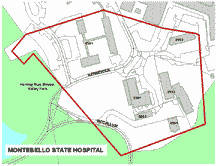Montebello State Hospital
National Register of Historic Places 10/30/98
 Description
Description
Sited on a 33.89-acre tract, Sydenham Hospital for Communicable Diseases (later known as the Montebello State Chronic Disease Hospital) is located in Baltimore, west of herring Run and adjacent to the city's water filtration plant. The hospital campus, as originally constructed in 1922-24 consist of seven buildings: the main hospital building, the administration building, the kitchen, the nurses' home, the laundry with servants' quarters above, the garage, and the power house. In 1939, a residence for the Director of Medical Research was added at the west and of the campus. The campus was designed by noted Baltimore architect Edward Hughes Glidden, Sr. Its institutional-scale, buff brick buildings with stone and terra cotta trim is presented in the Italian Renaissance Revival style, characteristic of the 1920s.
The buildings are placed within a campus like setting with the main hospital building serving as the anchor from which the other buildings are located throughout the grounds. The administration building and the kitchen are positioned as two projecting wings from the hospital building, creating a collegiate setting. Walkways and courtyards lead to the other buildings sited more informally and slightly separated from this main grouping of buildings. After the hospital closed in 1949, the site was assumed by the Montebello State Chronic Disease Hospital. Several buildings were constructed on the campus by subsequent owners between 1954 and 1984.
Significance
Located in northeast Baltimore, north of Lake Montebello, Sydenham Hospital was constructed in 1924 as a hospital for the treatment of communicable diseases. The area surrounding Sydenham hospital is notable for the presence of such prominent Baltimore landmarks as the City Filtration plant, and Clifton Park, as well as several substantial institutions including Morgan State University, Eastern High School, and City College. The hilly site overlooks several bodies of water including Herring Run, Quarry Pond, Lake Montebello, and Wash Water Reservoir. Sydenham Hospital, a Baltimore City hospital, is both historically and architecturally significant. A number of treatments were pioneered at Sydenham, allowing for the development of break-through procedures in the field of communicable diseases. Furthermore, Sydenham Hospital provides a fine example of 1920's hospital planning and design as well as an excellent illustration of the work of prominent Baltimore architect, Edward Hughes Glidden, Sr.
 Description
Description